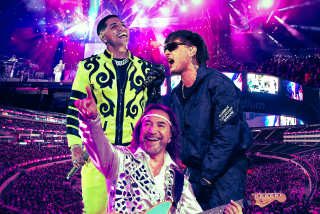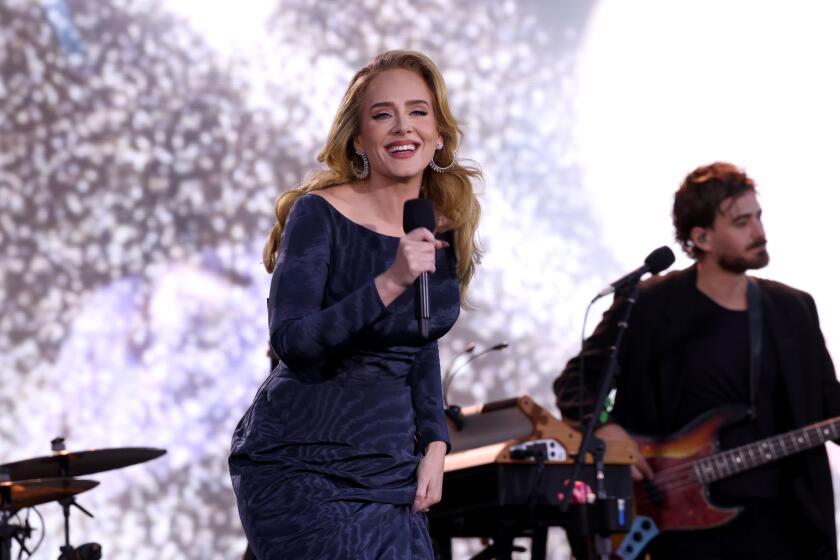Luis Miguel’s Crossroad
He’s young, handsome and popular almost beyond belief. He has sold an estimated 45 million albums worldwide and regularly fills 50,000-seat stadiums. He’s a stylish performer who counts Frank Sinatra among his idols.
So, when’s Latin pop superstar Luis Miguel finally going to say si to recording in English?
It’s a question that was raised in some quarters of the pop world in 1994 when the Mexican singer’s “Segundo Romance” became the first Spanish-language album to be certified as a million-seller in the United States.
It was reintroduced in 1995, when the charismatic 27-year-old performer sang “Come Fly With Me” in English at the 80th-birthday salute to Sinatra at the Shrine Auditorium.
Remarkably, he stole the show from the likes of Bob Dylan, Bruce Springsteen and even Tony Bennett by reflecting much of the snap and style of Sinatra’s own ring-a-ding image.
And the question is likely to be raised again as the word of mouth from Luis Miguel’s triumphant new U.S. tour begins filtering through the pop world.
His dazzling concert Thursday night at the Universal Amphitheatre--the first of his five shows in the 6,000-seat facility--helped explain why he enjoys such phenomenal success.
The show was a marvelously designed and wonderfully executed blend of Latin music tradition--including segments devoted to boleros and mariachi--and contemporary sensibilities.
Though you didn’t need to know the language to get caught up in the energy and passion of the performance, the show would surely be more accessible to most U.S. pop fans if Luis Miguel sang in English.
You got a hint of the potential impact when he sang “Besame Mucho,” a song that has been recorded scores of times in English since it was written in 1944 by Consuelo Velazquez. Even though Luis Miguel sang it in Spanish, the familiarity of the song made it seem far more immediate than the other material Thursday.
While he could build an English base through word of mouth, a few key recordings would more quickly do the trick.
Luis Miguel’s agent, Peter Grosslight of William Morris, thinks the singer could “quadruple” his popularity by expanding his music to an English-speaking audience in this country and in Europe.
That could add up to whopping figures since Luis Miguel’s success on the Latin pop scene alone makes him one of the most popular singers in the world. His latest album, “Romances,” entered the U.S. pop chart last month at No. 14 and he’s expected to gross about $500,000 a night on an upcoming U.S. arena tour. He may return to Southern California early next year for more shows, possibly two arena appearances.
Emily Simonitsch, vice president of special markets for Universal Concerts, which books the Amphitheatre shows, agrees that the singer has tremendous crossover potential. “He’s a fabulous, charismatic performer.”
So what are the chances that he will attempt a crossover?
Luis Miguel--whose last name is Gallego, but who uses his two first names professionally--no doubt likes all the mystery surrounding his decision. In an interview on the eve of the Universal Amphitheatre show, the singer, who speaks English fluently, said he thinks it’s important for celebrities to maintain a certain degree of mystique.
But he’s also clearly nervous about the English-language issue.
For one thing, he feels uncomfortable being seen as part of what he calls the “crossover-artist stereotype,” someone who thinks, for reasons of ego or record sales, that he needs success in the English-language world to validate his artistry or stardom.
Mostly, however, one senses his reservations have to do with his perfectionism.
“When I go on stage, I want to transmit certain emotions and the best way to do it is with my own language, which is Spanish,” says the singer, who has homes in Los Angeles, where he records his albums, and in Acapulco, where he tends to stay when he’s not working.
“In English, I can communicate, but not as well. . . . I need to find the right record producer, the right songs . . . and that takes time. I am very busy now in my Spanish world. I’m young. I’m patient. I probably will make the album some day, but I don’t want to do it until I know I will do it right.
“It’s not important to me to make an English album just because of marketing . . . just to be No. 1 in Billboard [in the U.S.]. We already [reached] No. 14 with my new Spanish album.”
As remarkable as his commercial success, the most noteworthy feature of Luis Miguel’s career is his dedication to artistry.
He brings a seriousness to the often lightweight world of mainstream Latin pop, a dedication to craft that is all the more impressive given his own teenage pop background in Mexico.
Guided in show business by his late father, singer Luisito Rey, Luis Miguel was a superstar in Latin America before he entered his teens. By 16, however, he felt frustrated musically and boldly declared his independence by severing professional ties with his father. Since then, he has largely managed himself.
Though he has blossomed as an artist on his own, he still credits his father for his artistic drive.
“The main thing for me has always been the music, not just the fame,” Luis Miguel says. “I wanted to do it well. I had certain heroes . . . from Javier Solis and Pedro Infante in Mexico to Frank Sinatra and more in this country. I wanted to be like them . . . the style and the class.
“My father taught me that if you are going to do something, you do it well. He was very, very strict and it made an impression on me when I was young and getting started. It became important to me . . . to do things right and not embarrass yourself.”
His own dedication is evident throughout the show. The tendency of most mainstream pop stars (whether singing in English or Spanish) is to be either melodramatic or bland, and Luis Miguel is free of both traits.
For this tour, he has designed a quickly paced 2 1/2-hour show that combines some of his upbeat, dance minded hits with a string of the bolero numbers that have served as the foundation of three recent albums, and even a brief mariachi segment.
He is accompanied by a battery of musicians, including a six-piece band that applies a contemporary R&B;/funk edge to much of the music, a 10-piece string section that is utilized chiefly during the boleros and by a 13-piece mariachi band. He is also joined at times by three female singers.
Despite the large lineup, Luis Miguel uses the musicians wisely, leaving space for intimacy and character. While he exudes some of the supper-club charisma and command of Sinatra, it’s misleading to carry the comparison too far. There is more of a pop-rock energy to his musical arrangements and to his constant twists and turns on stage. He’ll even punctuate a line with a sudden skip or leap.
But none of the show-biz dynamics draws from the focus on the songs.
Watching him, it’s obvious why he’s reluctant to test himself in English until he’s confident he can deliver just as strong a show.
“Music is my life,” he said during the interview. “My stage is my church. I still get nervous before a show. I don’t know why. I think about it a lot. I’ve done, what, 1,000, 2,000 live performances. I even get nervous every time I make a record.
‘I don’t want to lose something that I have . . . the respect that I think I’ve achieved. It’s like every album and every show is a test. You have to work at it every time. You can never take it for granted.”
* Luis Miguel appears tonight through Monday at the Universal Amphitheatre, 100 Universal City Plaza, Universal City. $53-$68 (tonight and Sunday sold out). (818) 622-4440.
More to Read
The biggest entertainment stories
Get our big stories about Hollywood, film, television, music, arts, culture and more right in your inbox as soon as they publish.
You may occasionally receive promotional content from the Los Angeles Times.










